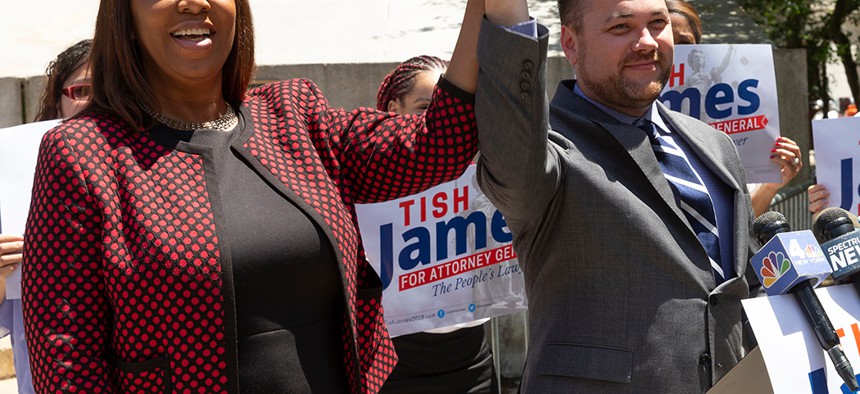Ever since New York City Public Advocate Letitia James became the clear frontrunner for New York attorney general, there was speculation about who replace her. On Tuesday, voters will finally determine who will succeed James.
The office, whose occupant would replace the mayor if he left office before completing his term, is seen by many as a stepping stone for a mayoral bid. Mayor Bill de Blasio was public advocate immediately before becoming mayor, and James had widely-rumored mayoral aspirations before entering the attorney general’s race.
That is not merely a consequence of the political aspirations of those who have held the office – it had actually been one intended purpose of the role when it was created by the city’s 1989 Charter Revision Commission, according to Eric Lane, who served as executive director and counsel of the commission. With the elimination of the once-influential New York City Board of Estimate and the creation of the City Council speaker, the now non-existent role of City Council president would become largely ceremonial. So Lane said that after much debate, the commission decided to keep the public advocate position and redefine it so as to give more people of color an opportunity to get involved in city government. “One of our goals was minority opportunity to get a sort of platform to reach for higher office, to get get citywide visibility,” Lane told City & State.
Before former Mayor David Dinkins, who was elected shortly after the commission, no non-white person had ever been elected to citywide office. Lane said the commission wanted that to change. That sentiment was also the reasoning behind increasing the number of City Council seats to 51.
However, the position of public advocate is not only a springboard, nor was it envisioned simply as one. Lane said the other intent was to create a government watchdog to oversee such a large municipality and to serve as an ombudsman for the people.
Originally, the public advocate also presided over the City Council, but that responsibility was transferred to the council speaker after the 2002 charter revision. While the public advocate can sit in meetings and introduce legislation, she has no voting power.
Lacking control over any aspect of the government, the public advocate can simply bring attention to issues in hopes that someone else would take action.
Each of the four public advocates so far have taken their own approaches towards how best to bring about change. The city charter does not specifically lay out what the public advocate should be doing as watchdog, creating a malleable position that is very much shaped by whoever holds the office at the time.
“Everybody brings their own style and substance to the post,” Mark Green, the city’s first public advocate, told City & State. “The office has as much impact as the person who runs it.”
During his time in office, Green said he wanted to be a founding father in the role, to ensure that the position lived on despite lack of public support at the time. He took an active role in challenging then-Mayor Rudolph Giuliani on issues like police misconduct and went on to win the Democratic nomination for mayor in 2001.
The city’s second public advocate, Betsy Gotbaum, described her tenure differently. She said that unlike Green and Giuliani, she got along well with then-Mayor Michael Bloomberg, who was more moderate and less combative than his fellow Republican predecessor, so she did not feel the need to challenge him as frequently and aggressively. Gotbaum said that her power lay in working behind the scenes, utilizing her existing relationships in government to affect change and help New Yorkers. “It’s a very tough office to understand how to run it,” Gotbaum told City & State.
During his time in the position, de Blasio had a different style than either of his predecessors, publicly calling out wrongdoing on the part of bad actors in the city, and, as Gotbaum put it, “shaming people into behaving.” One such effort was de Blasio’s list of the city’s worst landlords, a yearly tradition continued by Public Advocate James to this day.
James has also pushed the boundaries of the office’s powers, opting to use the position to file lawsuits against the city and city agencies, with mixed success. Although she was not the first public advocate to bring suits on issues such as foster care, hot school buses and the city’s rent freeze program, she has filed the most and done so very publicly.
However, the public advocate’s office can still find itself at the mercy of the government that it is meant to oversee. The office does not have a guaranteed budget, something Lane now considers an oversight during the 1989 charter revision commission. This means that every year, the City Council and the mayor decide how much funding the public advocate gets.
When asked whether the office of public advocate plays an important role or is merely a soapbox mayoral hopefuls can use to increase their profile, Green said its impact largely relies on who’s running it, but that high aspirations alone will not get someone elected. “The best, if only way, to pursue higher office is to do a hell of a job in the former one. And voters know,” Green said.


